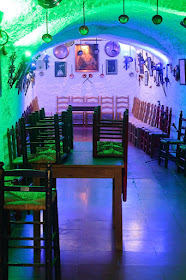Rising above the modern lower town, the Alhambra and the Albayzín, situated on two adjacent hills, form the medieval part of Granada. With sugar-white houses, the ancient barrio of El Albayzín retains the narrow winding streets of its Medieval Moorish past dating back to the Nasrid Kingdom of Granada. This ancient Moorish stronghold is today one of Andalucia's most scenic cities, with a dramatic setting in the foothills of the Sierra Nevada, crowned by the graceful Alhambra Palace, designated a Unesco World Heritage Site in 1994 along with the ancient citadel. With so much to see, we explored ancient Granada with our Tours by Locals guide Mirian, as we learned about Granada's Moorish heritage strolling through a labyrinthine of serpentine steep cobblestone streets and up into the cave-studded Roma enclave of Sacromonte, the cradle of zambra flamenco.
Casa Horno De Oro was built in the late 15th century and expanded after the Christian conquest, with its architecture a synthesis of both Muslim and Christian cultures, known as Mudejar
The Albayzin quarter is dotted with historic Carmen homes, which comes from the Arabic word Karm or “grapevine”, and traditionally have private gardens with grape vines and fruit trees
An elegant private Carmen on a quite square in upper Albayzin
Colourful wisteria cascades over the wall of Carmen de la Mazaba
Lo and behold, a little girl and photographer show up for a photoshoot
Poised with a lovely dress and beautiful smile
Our guide Mirian's favourite restaurant, Carmen Aben Humeya, chosen as the most romantic restaurant in Granada — a definite must-do when we come back to Andalusia
Restaurante Carmen Aben Humeya terrace dates from the 15th Century and it is built on the top of the ancient wall of Granada
Table at Carmen Aben Humeya with sensational views of the Alhambra
The Mosque of Granada in the Albaicin quarter
Panoramic views of the Alhambra from the Mosque courtyard
Flamenco guitarist playing in the hilltop Plaza Mirador de San Nicolás,
one of the city’s most renowned lookout points
Museo Max Moreau
The bright little studio of Belgian artist Max Léon Moreau, who, having spent more than 30 years in the city bequeathed all his estate to the City Hall of Granada upon his death in 1992
Painting by Max Moreau
La Tunisie by Max Moreau , 1934
Self portrait
Local market with organic produce
Local artichokes
Raw sheep's milk cheese cured in the Sierra mountains of Zamora in Granada
Original Moorish archway to the Albaicin neighbourhood of Granada
Homemade Piononos from Heladeria, a typical cake of Granada
Heladeria is a famous pastry shop in Granada
Narrow Medieval streets of the Albaicin
Sardines in a local Pescaderia
Gorgeous thick homemade Arabic pita
Even with maps, it's very easy to lose ones way in the winding narrow streets of the Albaicin
Making the climb up to the Sacremonte district, home to Granada's
thriving Roma gypsy community
Roma cat basking in the sun
The cave-studded neighbourhood of Sacromonte is spread out over the dusty,
cactus-studded countryside high above Granada
Spectacular view from the top of Sacremonte
Flamenco club built into one of the original caves that the gypsies have inhabited
for hundreds of years
After the fall of the Moorish empire in the 1500's,
the Roma arrived and carved cave homes into the sacred hills of Sacromonte above the Albayzin
View over the centuries old cave dwellings of Sacremonte to the Rio Darro canyon below
Climbing airway down with a Sacremonte Roma guitar player leading the way
Narrow streets wind down to the Albaicin
El Buñuelo is the oldest and best preserved Arab bath or hammam in Andalusia and dates back to the Zirid era of the 11th century during the Moorish conquest
Beautiful mosaic-style stone patio
A Hammam, or Bañuelo, is an intrinsic part of Moorish culture
Arab baths consist of three rooms: a 'cold chamber' or frigidarium, next to that the slightly larger and arched 'warm chamber' or tepidarium, and the most important room being the 'hot chamber' or caldarium with actual baths
The barrel vaulted ceiling has star and octagon-shaped skylights which provided ventilation
and help adjust the heating and also had the effect of stars shining above
Also preserved at El Bañuelo are columns in Roman and Visigothic styles which indicate previous use of the waters of the River Darro by other cultures
The baths were one of the few Hammams that were not destroyed by the Catholic Monarchs following the Reconquista, as Phillip II deemed them to be sinful
A street poet sits by her typewriter on the cobblestone Carrera del Darro
Walking to lunch at Restaurante El Trillo along the Darro river















































No comments:
Post a Comment